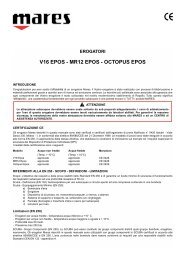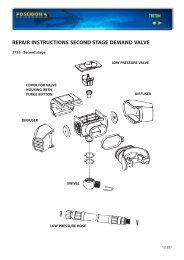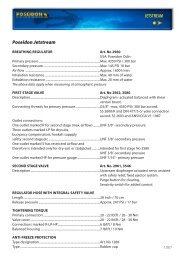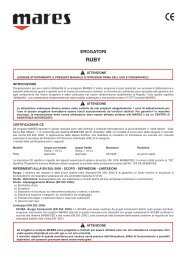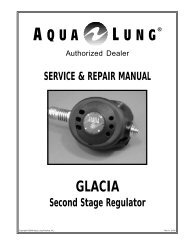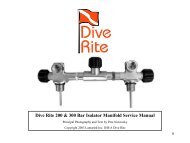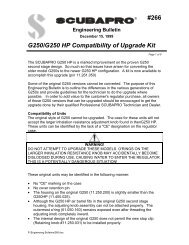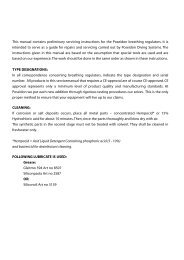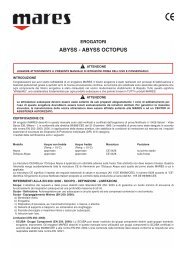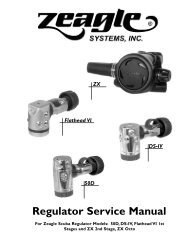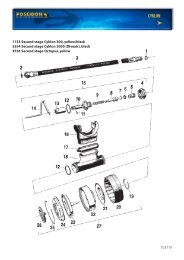LPO Service Manual.pdf - Aberdeen Watersports
LPO Service Manual.pdf - Aberdeen Watersports
LPO Service Manual.pdf - Aberdeen Watersports
- No tags were found...
You also want an ePaper? Increase the reach of your titles
YUMPU automatically turns print PDFs into web optimized ePapers that Google loves.
®Authorized DealerSERVICE & REPAIR MANUALL P OSecond Stage RegulatorCopyright ©2000 Aqua Lung America, Inc.Doc. No. XXXX-XX
ContentsIntroduction .................................................................................................... 1Warnings, Cautions, & Notes ........................................................................................... 1Scheduled <strong>Service</strong> ........................................................................................................... 1General Guidelines ........................................................................................................... 1Initial Inspection Procedure .......................................................................... 2External Inspection ........................................................................................................... 2Pressure Test .................................................................................................................... 2Disassembly Procedures............................................................................... 3Reassembly Procedures................................................................................ 6Valve Adjustment Procedures....................................................................... 8Final Assembly & Testing Procedures ......................................................... 9Second Stage Air Flow Test............................................................................................ 10Second Stage Opening Effort Test ................................................................................. 10Second Stage Purge Flow Test ...................................................................................... 10External Leak Test .......................................................................................................... 11Subjective Breathing Test ............................................................................................... 11Table 1 – Troubleshooting Guide ................................................................ 12Table 3 – Standard Parts Replacement Schedule ..................................... 13Table 2 – Recommended Tool List .............................................................. 13Table 5 – Test Bench Specifications ........................................................... 14Table 4 – Torque Specifications .................................................................. 14Procedure A – Cleaning & Lubrication....................................................... 15Table A – Recommended Lubricants & Cleaners...................................... 16Schematic Drawing – <strong>LPO</strong> Second Stage .................................................. 17
Doc. #XXXX-XX<strong>Service</strong> & Repair <strong>Manual</strong> - <strong>LPO</strong> Second Stage RegulatorIntroductionThis manual provides factory prescribed proceduresfor the service and repair of the <strong>LPO</strong> secondstage regulator. It is not intended to be used as aninstructional manual for untrained personnel. Theprocedures outlined within this manual are to beperformed only by personnel who have receivedfactory authorized training through a factory sponsoredAqua Lung <strong>Service</strong> & Repair Seminar.If you do not completely understand all of theprocedures outlined in this manual, contact AquaLung to speak directly with a Technical Advisorbefore proceeding any further.Warnings, Cautions, & NotesPay special attention to information provided inwarnings, cautions, and notes that are accompaniedby one of these symbols:A WARNING indicates a procedure or situationthat may result in serious injury or death ifinstructions are not followed correctly.A CAUTION indicates any situation or techniquethat will result in potential damage to theproduct, or render the product unsafe if instructionsare not followed correctly.A NOTE is used to emphasize importantpoints, tips, and reminders.Scheduled <strong>Service</strong>Regulators should be given the same care andmaintenance as life support equipment. It is thereforeimportant to perform scheduled overhaul servicefor the <strong>LPO</strong>, complete with first stage, according tothe procedures outlined in this manual; at least oncea year with normal or infrequent use.NOTE: A unit that receives heavy or frequentuse, such as in rental, instruction, or commercialapplications, should be serviced at leasttwice each year - or more often - depending onthe conditions of use and the manner in whichit is maintained. (Refer to the care and maintenanceprocedures outlined in the RegulatorOwner’s <strong>Manual</strong>.)GENERAL GUIDELINES1. In order to correctly perform the proceduresoutlined in this manual, it is important to followeach step exactly in the order given. Read overthe entire manual to become familiar with allprocedures before attempting to disassemble orservice the <strong>LPO</strong> second stage, and to learnwhich specialty tools and replacement parts willbe required. Keep the manual open beside youfor reference while performing each procedure.Do not rely on memory.2. All service and repair should be carried out in awork area specifically set up and equipped forthe task. Adequate lighting, cleanliness, andeasy access to all required tools are essential formaintaining a professional repair facility.3. Before beginning any disassembly, it is importantto first perform the Initial Inspection procedure,and refer to Table 1 - Troubleshooting todetermine the possible cause of any symptomswhich may be present.4. As each individual regulator is disassembled,reusable components should be segregated toprevent them from mixing with non-reusableparts or parts from other regulators. Delicateparts, and those which contain critical sealingsurfaces, must be protected and isolated fromother parts to prevent damage during the cleaningprocedure.5. Use only genuine Aqua Lung parts purchaseddirectly from Aqua Lung when servicing anyAqua Lung product. Substitution with anothermanufacturer’s parts constitutes an after-marketmodification of the product, and renders theoriginal warranty null and void.6. Do not attempt to reuse mandatory replacementparts under any circumstances, regardless of theamount of use the product has received since itwas manufactured or last serviced.7. When reassembling, it is important to followevery torque specification prescribed in thismanual, using a calibrated torque wrench. Mostparts are made of either marine brass or plastic,and can be permanently damaged by unduestress caused by overtightening.
2 <strong>LPO</strong> Second Stage <strong>Service</strong> & Repair <strong>Manual</strong>Initial Inspection ProcedureEXTERNAL INSPECTION1. Visually inspect the sintered filter to check for any signs thatcontaminants may have entered the system, such as moisture,rust, aluminum oxide, or charcoal.NOTE: A green discoloration positively indicates that moisturehas entered the regulator, and internal corrosion istherefore likely to be found in the first stage. A white or rustcolored residue usually indicates that the regulator has beenused with a corroded aluminum or steel cylinder. Advise thecustomer of the proper methods for maintaining the regulator,and the possible need to obtain service for their cylinder.2. Slide back the hose protector(s) to inspect the condition of theLP hose at its fittings and along its length. Check closely forany signs of blistering or abrasion, or corrosion of the fittings.3. Inspect the condition of the mouthpiece to check for torn bitetabs, holes, or deterioration.PRESSURE TEST1. Prior to performing any disassembly, ensure that the secondstage is connected to a first stage with a stable intermediatepressure of 135-140 psi, with no open ports or hoses.2. Listen closely to check for any signs of leakage from thesecond stage. If necessary, immerse the second stage in waterto locate the source of any leakage found and refer to Table 1- Troubleshooting to determine its possible cause.CAUTION: If the second stage freeflows uncontrollably,immediately shut the cylinder valve and proceed directly tothe Disassembly Procedure. Do not attempt to furtherinspect the regulator while pressurized.3. Depress the purge button to determine whether sufficientairflow is provided to clear the second stage of water. Immediatelyafter releasing the purge button, listen closely toensure that no air continues to flow from the second stage.4. Turn the cylinder valve shut and depress the second stagepurge button to depressurize the regulator before proceedingto the following Disassembly Procedure.© 2000 Aqua Lung America, Inc.
<strong>LPO</strong> Second Stage <strong>Service</strong> & Repair <strong>Manual</strong> 3Disassembly ProceduresNOTE: Before performing any disassembly, refer to Table 4,which references all mandatory replacement parts. Theseparts must be replaced with new, and must not be reusedunder any circumstances - regardless of the age of theregulator or how much use it has received since it was lastserviced.CAUTION: To prevent damage to critical sealing surfaces,use only a plastic or brass O-ring removal tool (P/N 9440-22)when removing O-rings. Once an O-ring sealing surface hasbeen damaged, the part must be replaced with new in orderto prevent the possibility of leakage. DO NOT use a dentalpick, or any other type of steel instrument.1. While holding the inlet fitting(19) of the second stage securewith a 19mm open end wrench, apply a 17mm (n") openendwrench to the female fitting of the LP hose(23). Turn thefitting counter-clockwise to loosen and remove the hose fromthe second stage. Remove the O-rings(22&24) from the hoseand discard. Set the hose aside.2. Carefully snip the plastic mouthpiece clamp(14) and removethe mouthpiece(13) from the box bottom(15). Inspect themouthpiece to ensure it is free of any tears or cuts that maycause leakage of water into the second stage or other discomfort.Discard the mouthpiece or set it aside to be reused,depending on its condition.3. While holding the second stage secure, firmly grasp the colorring(2) which holds the purge cover(1), and turn it counterclockwiseto loosen and remove from the box bottom.4. While holding the color ring with both hands, press inwardagainst the top of the purge cover to remove it from the colorring. Closely examine the color ring for any signs of threaddamage, and inspect the purge cover to check for any signs ofdeterioration, distortion, or other damage. Replace with newif any damage is found, or set these parts aside if they are inreusable condition.5. Lift out the diaphragm(4) with retaining ring(3) and separatethese items to closely inspect the diaphragm for any signs oftears, deterioration, or other damage. If deterioration ordamage is found, discard the diaphragm and do not attempt toreuse.6. While holding the box bottom secure, apply a 19mm openend wrench to the inlet fitting(19). Hold the lever(10) depressed,and carefully turn the fitting counter-clockwise toloosen and remove. Remove and discard the O-ring(18).7. Apply a medium blade screwdriver to the slotted head of thecrown(20) inside the inlet fitting, and hold the inlet fitting© 2000 Aqua Lung America, Inc.
4 <strong>LPO</strong> Second Stage <strong>Service</strong> & Repair <strong>Manual</strong>secure while turning the crown counter-clockwise to disengagethe threads.NOTE: Because the crown is O-ring sealed, it will not freelyexit the valve body after it has been disengaged. The followingstep must be performed correctly in order to remove thecrown without damaging its delicate sealing surface.8. When the crown has been unthreaded from the inlet fitting,carefully insert the pin of the extraction tool (P/N 1094-36)into the opposite end of the inlet fitting and through the centerof the crown. Gently press the crown out onto a paddedsurface (see Fig. 1). Remove and discard the O-ring(21).9. Closely examine the crown with the use of magnifier to checkfor any scoring, nicks, or other damage to the polished sealingsurface. If damage is found, discard the crown, and do notattempt to reuse. If it is in reusable condition, set it aside on asoft surface to prevent damage to the sealing edge.10. Press the valve body(9) with lever assembly into the boxbottom by inserting a finger through the inlet opening. Gentlylift the assembly out of the box bottom, being careful toavoid pulling or tugging on the lever(10).11. Stand the valve assembly vertical on the head of the poppet,with the lever facing up, and depress the valve body to exposethe locknut(12). While holding the valve body fully depressed,apply a 4" nut driver to turn the locknut counterclockwiseuntil it has disengaged from the threads of thepoppet (see Fig. 2). Remove the locknut, washer(11), andlever, and slowly relax the valve body to lift it off the poppet(6)and spring(7). Discard the locknut, and do not attemptto reuse.12. Closely inspect the shape and condition of the lever to ensureit is not bent, corroded, or otherwise damaged. If any signs ofdamage or corrosion are found, discard the lever and do notreuse.13. Closely examine the poppet spring with a magnifier to ensureit is not damaged (bent) or corroded. If any signs of damageor corrosion are found, discard the spring and do not reuse.14. Using a plastic or brass O-ring tool, lightly stick the center ofthe LP seat(5) inside the head of the poppet and lift the seatout, being very careful to avoid damaging the poppet. Set theseat aside to be used as an aid during reassembly, and inspectthe head of the poppet to check for any nicks, scratches, orother signs of damage. The through-hole beneath the LP seatcavity should be clear and free of any obstructions. If anysigns of damage are found, discard the poppet and do notattempt to reuse.Fig. 1 – Crown RemovalFig. 2 – Disassembly of Valve© 2000 Aqua Lung America, Inc.
<strong>LPO</strong> Second Stage <strong>Service</strong> & Repair <strong>Manual</strong> 5NOTE: The used LP seat is an essential aid to the reassemblyprocedure for the valve body. Do not discard the seatuntil the reassembly and final adjustment procedures haveboth been performed, and the regulator is functioning satisfactorily.Fig. 3 – Removing Exhaust Diaphragms15. Place the handle of the extraction tool directly over the poppetbearing(8) in the top center of the valve body, and pressdownward until the poppet bearing has dropped out. Discardthe poppet bearing, and do not reuse.16. To remove the exhaust valve diaphragms(16), it is not necessaryto remove the exhaust cover(17). Instead, use a pair ofneedle nose pliers to pull each of the diaphragms through thegrill of the exhaust cover (see Fig. 3). Discard both diaphragms,and do not reuse.CAUTION: Aqua Lung recommends that the exhaust covershould not be removed unless it appears to be damaged andrequires replacement. If removal and replacement is necessary,proceed with caution, being careful to avoid damagingthe box bottom.This concludes the disassembly of the <strong>LPO</strong> secondstage. Refer directly to Procedure A and Table A, titledCleaning & Lubrication, before proceeding to the ReassemblyProcedures.© 2000 Aqua Lung America, Inc.
6 <strong>LPO</strong> Second Stage <strong>Service</strong> & Repair <strong>Manual</strong>Reassembly ProceduresNOTE: Before performing any reassembly, it is important toinspect all parts, both new and those that are being reused,to ensure that every part and component is perfectly cleanand free of any dust, corrosion, or blemishes. Check all O-rings to ensure they are clean and supple before dressingwith either Christo-Lube ® or Dow 111 silicone grease.WARNING: Use only genuine Aqua Lung parts, subassemblies,and components whenever assembling any Aqua Lungproduct. DO NOT attempt to substitute an Aqua Lung partwith another manufacturer’s, regardless of any similarity inshape, size, or appearance. Doing so may render the productunsafe, and could result in serious injury or death.1. Install each exhaust valve diaphragm(16) into the box bottom(15)by feeding the stem of the diaphragm through theexhaust cover(17) and into the center hole of the valve in thebox bottom. Gently pull the stem through the hole on theopposite side inside the box bottom, until the barb has passedthrough and is securely seated against the opposite side.Carefully snip off the excess material of each stem with asmall pair of scissors.2. Install the O-ring(21) onto the crown(20), and carefully insertthe threaded end of the crown into the hose connection of theinlet fitting(19). Gently press it in further with the blunt endof the extraction tool (P/N 1094-36) until it stops (see Fig. 4).3. Apply a medium blade screwdriver to the slotted head of theadjustable crown, and turn the crown clockwise to engage thethreads. Continue turning the crown clockwise to the fullextent of its thread engagement, and stop turning whenresistance is felt. Then turn the crown out counter-clockwiseexactly 22 turns counterclockwise to arrive at its correctpreliminary setting.4. Stand the inlet fitting vertical on a flat surface with the sealingedge of the crown facing up inside. Install the O-ring(18) intothe groove at the base of the threads, just above the hexfeature.5. Lay the previously used LP seat inside the inlet fitting, overthe sealing edge of the crown (see Fig. 5).NOTE: It is essential to use a spare LP seat in order toprevent damage to the new seat while performing the followingsteps of the reassembly procedure.Fig. 4 – Crown InstallationFig. 5 – Using Old LP Seat as Spacer6. Place the poppet bearing(8) over the pin of the extraction toolwith the square feature facing up. Guide the pin of the toolinto the open end of the valve body(9) and out through thesquare hole in its center. While sighting through the top of© 2000 Aqua Lung America, Inc.
<strong>LPO</strong> Second Stage <strong>Service</strong> & Repair <strong>Manual</strong> 7the valve body, rotate the tool as needed to align the squarefeature of the poppet bearing with the square hole, and pressthe tool upward to seat the bearing securely in place (see Fig.6). When finished, check to ensure that the top of the poppetbearing is flush with the top of the valve body.7. Press the new LP seat(5) into the cavity in the head of thepoppet(6), with the smooth side facing out.8. Stand the poppet on its head inside the top of the inlet fitting,and place the spring(7) over the poppet shaft.9. Hold the inlet fitting secure, and mate the valve body withpoppet bearing down over the poppet shaft. Press the valvebody downward to compress the spring while turning itclockwise to engage the threads of the inlet fitting, and thencontinue turning it slowly until the threaded portion of thepoppet shaft stands outside the poppet bearing.Fig. 6 – Poppet Bearing Installation1-2 threadsFig. 7 – Locknut Preliminary SettingCAUTION: If resistance is felt, immediately stop and unscrewthe valve body from the inlet fitting to check the alignmentof the poppet shaft and poppet bearing. Excessiveforce and misalignment will otherwise result in damage to thepoppet bearing, requiring its replacement.10. While the inlet fitting and valve body are laying horizontal,rotate both parts until the outlet ports of the valve body facetowards 6 O’clock. Lay the arms of the lever(10) inside thegroove of the valve body, straddling the poppet shaft, so thatthe curved portion of the lever faces towards 12 O’clock.11. Place the washer(11) over the poppet shaft, followed by thelocknut(12), with the flat side facing down. Being careful toavoid disturbing the lever, turn the locknut clockwise by handto engage the threads of the poppet, and then apply a 4" nutdriver to turn it further; only until 1 thread of the poppet shaftis visible above the top of the locknut (see Fig. 7).12. Hold the valve body and lever stationary and upright with onehand, and slowly unscrew the inlet fitting counter-clockwiseto loosen and remove from beneath it, while watching toensure that the lever rises slightly as the poppet shaft retractsinto the valve body. Remove and discard the previously usedLP seat from the inlet fitting.13. After removing the previously used LP seat, reconnect thevalve body and inlet fitting and tighten finger snug so thatthey are flush with each other.NOTE: This concludes the preliminary reassembly proceduresof the main valve assembly. Do not proceed to reassemblethe <strong>LPO</strong> second stage any further until first followingthe adjustment procedures for the valve assembly outlined inthe following section.© 2000 Aqua Lung America, Inc.
8 <strong>LPO</strong> Second Stage <strong>Service</strong> & Repair <strong>Manual</strong>Valve Adjustment ProceduresCAUTION: Prior to adjusting and testing the <strong>LPO</strong> secondstage regulator, the accompanying first stage must be correctlyserviced, adjusted to a stable intermediate pressure of135-140 psi, and fully tested. Refer to the appropriate firststage service manual before attempting to perform theadjustment and testing of the <strong>LPO</strong> second stage.1. Thread the male fitting of the IP hose into the low pressureport of the first stage, and apply a torque wrench with 17mm(n") crow-foot to tighten to 40 inch-pounds (±2).2. Connect an intermediate pressure test gauge (P/N 1116-10) tothe first stage via a separate low pressure hose.3. Attach the female fitting of the second stage low pressurehose to the Inline Adjustment Tool (P/N 1001-95) by matingthe swivel nut onto the male threaded end of the tool. Turnthe swivel nut clockwise until finger snug.4. Pull back the knob of the tool to retract the adjusting stem,and mate the female threaded end of the tool onto the secondstage inlet fitting. While holding the tool secure, turn thevalve assembly clockwise until finger snug (see Fig. 8).5. Slowly open the valve of the air supply to pressurize the valveassembly. Press the knob of the inline adjustment tool inward,and gently turn the knob until it can be felt that theadjustment stem has mated into the slotted head of the crown.Continue to hold the knob inward, in order to prevent it frombeing pressed outward by the internal air pressure.a. If airflow cannot be heard, slowly turn the crown outcounter-clockwise only until a very slight leak is present.b. When a slight leak has been established, slowly turn thecrown clockwise in very small increments of adjustmentwhile lightly depressing the lever to cycle the regulator.Pause to listen after each adjustment to determinewhether the airflow has stopped. It is important to adjustonly until the airflow has stopped.c. When the airflow is stopped and no leakage can be heardafter cycling the regulator, proceed to adjust the crownfurther clockwise exactly 180 degrees. Then, release theknob of the inline adjustment tool to ensure that it nolonger makes contact with the crown.Fig. 8 – Inline Tool Connection1–2 mm freeplay while pressurizedCAUTION: Over-adjustment of the orifice crown will causeexcessive spring load in the second stage valve, and mayseverely degrade the performance of the regulator.6. Apply a hand driver with 4" tapered hex to turn the locknutclockwise in very small increments of adjustment; only untilthe lever stands just below its maximum height; with a veryslight amount (1–2 millimeters) of freeplay (see Fig. 9).Fig. 9 – Lever Height Adjustment© 2000 Aqua Lung America, Inc.
<strong>LPO</strong> Second Stage <strong>Service</strong> & Repair <strong>Manual</strong> 97. Lightly depress the lever several times to cycle the regulatorand listen closely to check for the return of any leakage,which may indicate that the locknut has been over-adjusted.If leakage is detected, it is important to return the crown andlocknut to their original preliminary settings, and then repeatsteps 5-6 before proceeding any further.CAUTION: Over-adjustment of the locknut will retract thepoppet from the crown, resulting in leakage past the LP seat.Do not attempt to correct this condition by only readjustingthe crown further in clockwise. Doing so may increase theopening effort and inhalation resistance of the regulator dueto excessive spring load in the second stage valve.Fig. 10 – Installing Valve AssemblyFig. 11 – Purge Cover Alignment8. When the crown and locknut are properly set with no leaksand the lever is standing at its correct height, turn the valve ofthe air source completely shut, and lightly depress the lever todepressurize the system. Disconnect the in-line adjustmenttool from the second stage valve assembly.9. While holding the lever partially depressed, unscrew the inletfitting from the valve body and set it aside.Final Assembly & Testing Procedures1. Lay the valve body and lever assembly inside the box bottomwith the lever facing up. Mate the valve body into the inletport of the box bottom until it is seated flush against the wallinside (see Fig. 10).2. While holding the valve body securely seated inside the boxbottom and the lever partially depressed, mate the shorterthreaded end of the inlet fitting through the port of the boxbottom. Turn the inlet fitting clockwise by hand until fingersnug, and then apply a torque wrench with a 19mm socket totighten it to a torque measurement of 50 (±5) inch-pounds.3. Lay the purge cover(1) over the top of the color ring(2) withthe logo facing up, and align the indexed tab on the side of thepurge cover with the slot inside the center of the color ring(see Fig. 11). Press the purge cover into the color ring,beginning with the indexed tab. When done, check to ensurethat it is seated evenly around its entire circumference.4. Lay the diaphragm(4) inside the box bottom, directly over thelever, with its raised center facing up. Check to ensure it isevenly seated over the shoulder on all sides at the base of thethreads. Then, place the retaining ring(3) directly over thediaphragm with the raised shoulder facing up, and press itfirmly downward to ensure it is seated evenly on all sides atthe base of the threads.5. Mate the color ring with purge cover over the box bottom, andturn the color ring clockwise to tighten until finger snug.© 2000 Aqua Lung America, Inc.
10 <strong>LPO</strong> Second Stage <strong>Service</strong> & Repair <strong>Manual</strong>6. Install the mouthpiece(13) onto the box bottom, and lightlyfasten a clamp(14) onto the groove of the mouthpiece. Turnthe clamp so that the locking tab is facing toward the inletside of the box bottom, and pull the clamp sufficiently snug.Snip the extra length with a small pair of scissors or wirecutters.NOTE: Before performing the following procedure, refer toTable 5, titled Test Bench Specifications - <strong>LPO</strong> 2nd Stage.NOTE: If an accurately calibrated airflow test bench is notavailable, proceed to the Subjective Tuning Proceduresprovided on the following page.SECOND STAGE AIR FLOW TEST1. Connect the first stage regulator to a calibrated test bench andpressurize the system to 3000 (±100) psi.2. Place the second stage mouthpiece over the mouthpieceadapter. Slowly turn the flowmeter control knob until theflow reaches a minimum of 15 SCFM (425 liters per minute).The reading on the Magnahelic gauge (inhalation / exhalationeffort gauge) should indicate no more than +6.O" H 2 O. If thereading exceeds +6.0" H 2 O, refer to refer to Table 1 - Troubleshootingfor corrective guidelines and specific procedures.SECOND STAGE OPENING EFFORT TEST1. Turn the flowmeter control knob shut, and then slowly reopenwhile watching both the Magnahelic gauge and the intermediatepressure gauge.2. When the intermediate pressure gauge begins to drop belowthe intermediate pressure “lockup,” the Magnahelic gaugeshould indicate an opening effort of +.8" to +1.4" of H 2 O(primary) or +1.2" to +1.8" (octopus). If the opening effort isnot within this range, refer to Table 1 - Troubleshooting.SECOND STAGE PURGE FLOW TEST1. Turn off the flowmeter control knob. Next, while the secondstage is still mounted on the mouthpiece adapter, watch theflowmeter gauge and depress the purge button until thesecond stage valve is completely open. The flowmeter gaugemust indicate a minimum of +5.0 SCFM (142 Liters perminute.). If the purge flow is less than +5.0 SCFM, refer toTable 1 - Troubleshooting.2. When purge flow is correct, remove the second-stage from themouthpiece adapter on the flow test bench. Shut the valve ofthe test bench, and purge the second stage to depressurize thesystem. Remove the regulator.© 2000 Aqua Lung America, Inc.
<strong>LPO</strong> Second Stage <strong>Service</strong> & Repair <strong>Manual</strong> 11EXTERNAL LEAK TEST1. After disconnecting the regulator from the flow bench, connectit to a scuba cylinder filled to approximately 3,000 psi.Open the cylinder valve to repressurize the regulator, andsubmerge the entire system in a test tank of clean water.2. Observe any bubbles arising from the submerged regulatorover a one minute period. The recommended time is necessarydue to slower bubble formation that occurs in smallerleaks. Bubbles indicate a leak, which requires that the systemmust be disassembled at the source to check sealing surfaces,assembly sequence and component positioning in order tocorrect the problem(s).NOTE: Extremely small leaks may be better detected byapplying a soap solution or Snoop to the leak area.Bubble streams will indicate the source of the leak. Beforedisassembling to correct any leaks, rinse the entire regulatorthoroughly with fresh water and blow out all residual moisturewith filtered, low-pressure (50 psi) air. Disassemble andremedy the problem, referring to Table 1 - Troubleshooting.SUBJECTIVE BREATHING TEST1. Depress the purge cover fully to ensure that an adequatevolume of air needed to clear the second stage flows throughthe mouthpiece. Then, inhale slowly but deeply from themouthpiece. A properly serviced and adjusted regulatorshould deliver air upon deep inhalation without excessiveinhalation effort, freeflow, or “fluttering” of the second-stagediaphragm. When exhaling, there should be no fluttering orsticking of the exhalation valve. If any of these problemsoccur, refer to Table 1 - Troubleshooting.This concludes annual service procedures for the<strong>LPO</strong> Second Stage.© 2000 Aqua Lung America, Inc.
12 <strong>LPO</strong> Second Stage <strong>Service</strong> & Repair <strong>Manual</strong>Table 1Troubleshooting Guide – <strong>LPO</strong> Second StageSYMPTOM POSSIBLE CAUSE TREATMENTLeakage or freeflow from 1. High first-stage intermediate pressure. 1. Refer to first-stage Troubleshootsecondstage (should be 135-140 psi) ing Guide.2. LP seat(5) damaged or worn. 2. Replace LP seat.3. Crown(20) and/or locknut(12) adjusted 3. Reset crown and locknut toincorrectly, lever set too high.preliminary settings, and repeatAdjustment Procedures.4. Crown(20) sealing surface damaged. 4. Replace crown.5. Poppet spring(7) damaged. 5. Replace poppet spring.Low purge or excessive work 1. Low intermediate pressure. 1. Refer to first-stage Troubleshootofbreathing (full cylinder) (should be 135-140 psi) ing Guide.2. Crown(20) and/or locknut(12) adjusted 2. Reset crown and locknut toincorrectly, lever set too low.preliminary settings, and repeatAdjustment Procedures.3. Intermediate pressure hose(23) 3. Clean or replace hose.clogged or obstructed.External air leakage 1. Intermediate pressure hose(23) loose. 1. Tighten to 40 inch-lbs at female(Immersion Test)second-stage fitting.2. Crown O-ring(21) damaged. 2. Disassemble and replace O-ring.3. Box bottom(15) damaged. 3. Disassemble and replace boxbottom.Water entering second-stage 1. Hole in mouthpiece(13). 1. Replace mouthpiece.2. Demand diaphragm(4) damaged. 2. Replace demand diaphragm.3. Exhaust diaphragm(16) damaged. 3. Replace exhaust diaphragm(s).4. Diaphragm(4) improperly seated 4. Remove color ring(2) and propbetweenbox bottom(15) anderly reassemble sealing ring withretaining ring(3).diaphragm . (Check for distortion.)5. Box bottom(15) damaged. 5. Disassemble and replace box(Check exhaust valve sealing surface.) bottom.6. Valve insert O-ring(18) damaged. 6. Disassemble and replace O-ring.CAUTION: Recommended treatments which require disassembly of the regulatormust be performed during a complete overhaul, according to the prescribed proceduresfor scheduled, annual service. Do not attempt to perform partial service.NOTE: This is a partial list of possible problems and recommended treatments. Formore information, refer to the second-stage troubleshooting guide, or contact theRepair Department for assistance with problems not described here.© 2000 Aqua Lung America, Inc.
<strong>LPO</strong> Second Stage <strong>Service</strong> & Repair <strong>Manual</strong> 13Table 2Recommended Tool ListPART NO. DESCRIPTION APPLICATION1116-10 I.P. test gauge Intermediate pressure testingN/A 0-120 inch-lbs torque wrench Inlet & hose fittings installation9440-22 O-ring tools O-ring removal & installationN/A Magnifier w/ illumination Sealing surface inspectionN/A Ultrasonic cleaner Brass & stainless steel parts cleaningN/A Medium blade screwdriver Crown removal/ installationN/A 17mm (n") wrench & crow foot IP hose fittingN/A 4" nut driver Valve disassembly/ assembly/ adjustment1094-36 Seat extraction/installation tool Crown removal & installation1001-95 In-line adjustment tool Final adjustment & tuningTable 3Standard Parts Replacement SchedulePART NUMBER DESCRIPTION KEY NUMBER QTY1025-10 Locknut 12 11041-34 Poppet Bearing 8 11067-38 LP Seat 5 18200-11 O-ring 24 18200-10 O-ring 21 & 22 28200-15 O-ring 18 11049-13 Clamp 14 11078-22 Exhaust Diaphragm 16 2© 2000 Aqua Lung America, Inc.
14 <strong>LPO</strong> Second Stage <strong>Service</strong> & Repair <strong>Manual</strong>Table 4Torque SpecificationsPART NUMBER DESCRIPTION / KEY NUMBER TORQUE0900-39 LP Hose Female Fitting / 23 40 (±3) inch-lbs1041-06 Inlet Fitting/ 19 50 (±5) inch-lbsTable 5Test Bench SpecificationsTEST CONDITION ACCEPTABLE RANGELeak test Inlet 2,500-3,000 (±100) psi NoneIntermediate pressure Inlet 2,500-3,000 (±100) psi 135-140 psiIntermediate pressure creep Inlet 2,500-3,000 (±100) psi5 psi max between 5 to 15 secondsafter cycling regulator (purge)Opening effort Inlet 2,500-3,000 (±100) psi, +.8 to +1.4 inch H 20 (primary)intermediate pressure 135-140 psi +.8 to +1.8 inch H 20 (octopus)Flow effort Intermediate pressure 135-140 psi +6 inches H 20 (maximum)at 15 SCFMPurge flow Intermediate pressure 135-140 psi 5.0 SCFM flow rate (minimum)© 2000 Aqua Lung America, Inc.
16 <strong>LPO</strong> Second Stage <strong>Service</strong> & Repair <strong>Manual</strong>Table ARecommended Lubricants & Cleaners(All Aqua Lung Regulators)LUBRICANT / CLEANER APPLICATION SOURCEChristo-Lube ® All O-rings seals; cylinder valve threads Lubrication Technologies(preferred for high pressure DIN systems) 310 Morton StreetJackson, OH 45640(614) 286-2644Dow Corning ® 111 All O-ring seals Dow Corning Corp.(pure silicone grease) P.O. Box 1767-TMidland, MI 48640800-248-2481CAUTION: Silicone rubber requires no lubrication or preservative treatment. DO NOTapply silicone grease or spray to silicone rubber parts. Doing so will cause a chemicalbreakdown and premature deterioration of the material.Silicone Pump General preservative/conditioner for McNett Corp.(non-aerosol silicone milk spray) hoses, instrument console boots, etc. P.O. Box 996Bellingham, WA 98227800-221-7325CAUTION: Aerosol spray silicone should be avoided because (1) common aerosolpropellants may attack plastic and rubber parts, and (2) because only a slight amountof silicone remains after the solvent evaporates, and provides no lasting benefit.Anti-Seize Lubricant #80208 M.A.S. cylinder adapter - female threads Permatex Industrial Corp.Micra ADJ adjustment screw705 N. Mountain Rd.Newington, CT 06111(860) 520-5000ChromeSafe Degreaser and acid bath for reusable Aqua Lung P/N 0201-05(ultrasonic cleaning solution) stainless steel and brass parts. (1 quart)Oakite #31 Acid bath for reusable stainless Oakite Products, Inc.steel and brass parts.50 Valley RoadBerkeley Heights, NJ 07922White distilled vinegar Acid bath for reusable stainless "Household" grade(100 gr.) steel and brass parts.CAUTION: DO NOT use muriatic acid for the cleaning of any parts. Muriatic acid,even when strongly diluted, can harm chrome plating, and may leave a residue that isharmful to O-ring seals and other parts.Liquid dishwashing detergent Degreaser for brass and stainless steel parts, "Household" grade(diluted with warm water) general cleaning solution for plastic, rubber,and anodized aluminum parts.Snoop Leak testing Nupro Company400 E. 345th St.Willoughby, OH 44094440-951-7100© 2000 Aqua Lung America, Inc.
<strong>LPO</strong> Second Stage <strong>Service</strong> & Repair <strong>Manual</strong> 17<strong>LPO</strong> Second Stage1234 587613121091920211118141522231616172425Key # Part # Description Key # Part # Description----- 9000-11 Overhaul Parts Kit1 ----- 1009-04 Purge Cover2 ----- 1009-06 Color Ring3 ----- 1009-09 Retaining Ring4 ----- 1001-81 Diaphragm5 ----- 1067-38 LP Seat6 ----- 1041-22 Poppet7 ----- 1041-27 Spring8 ----- 1041-34 Poppet Bearing9 ----- 1009-45 Valve Body10 ---- 1009-23 Lever11 ---- 1041-29 Washer12 ---- 1025-10 Locknut13 ---- 1058-31 Mouthpiece14 ---- 1049-13 Clamp15 ---- 1009-03 Box Bottom16 ---- 1009-22 Exhaust Valve Diaphragm17 ---- 1009-07 Exhaust Cover18 ---- 8200-15 O-ring19 ---- 1041-06 Inlet Fitting20 ---- 1078-05 Adjustable Crown21 ---- 8200-10 O-ring22 ---- 8200-10 O-ring23 ---- 0900-39 LP Hose24 ---- 8200-11 O-ring25 ---- 1009-24 Hose Retaining ClipPart numbers in BOLD ITALICS indicate standard overhaulreplacement part.© 2000 Aqua Lung America, Inc.
2340 Cousteau CourtVista, California 92083Phone (760) 597-5000Fax (760) 597-4900www.aqualung.com



